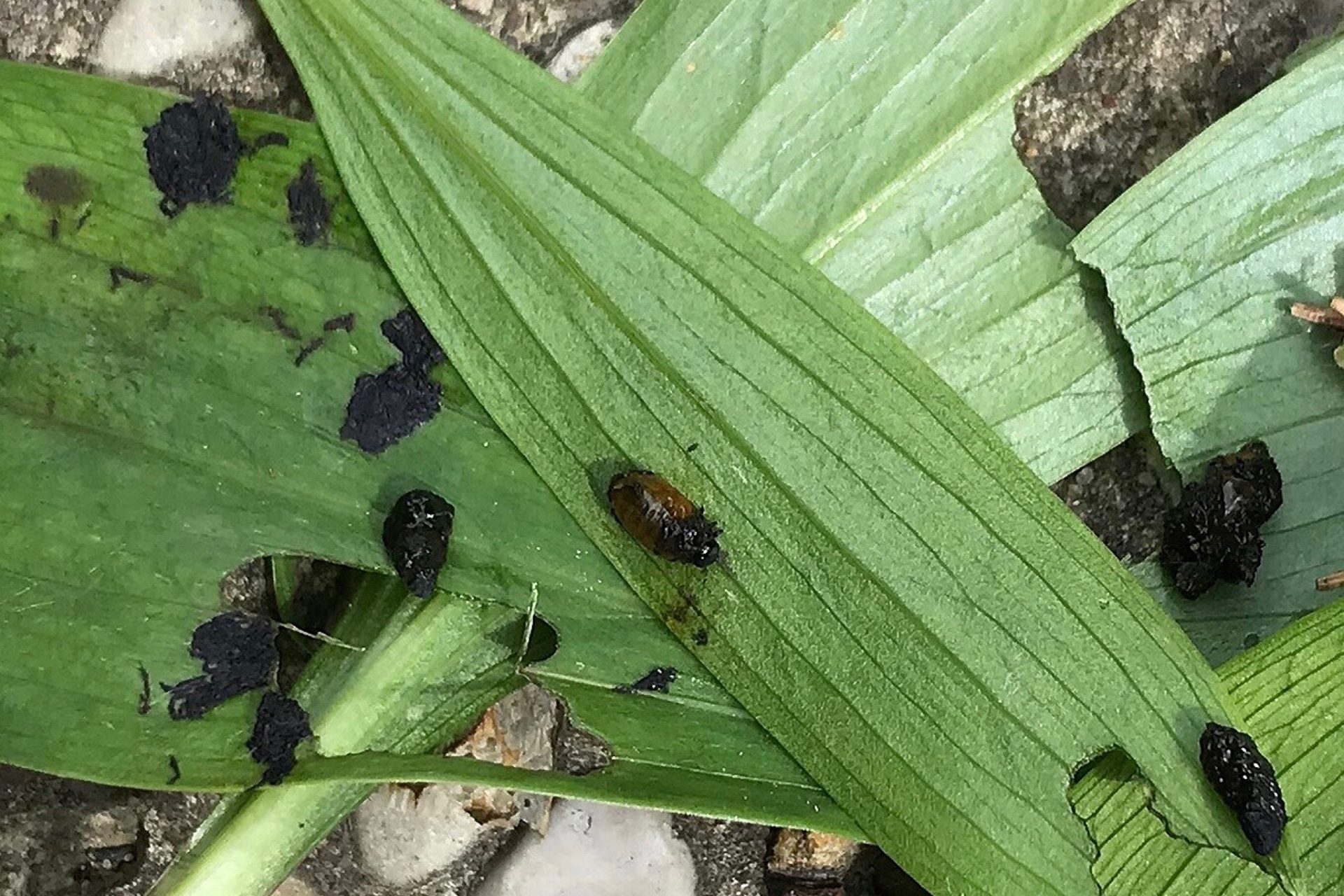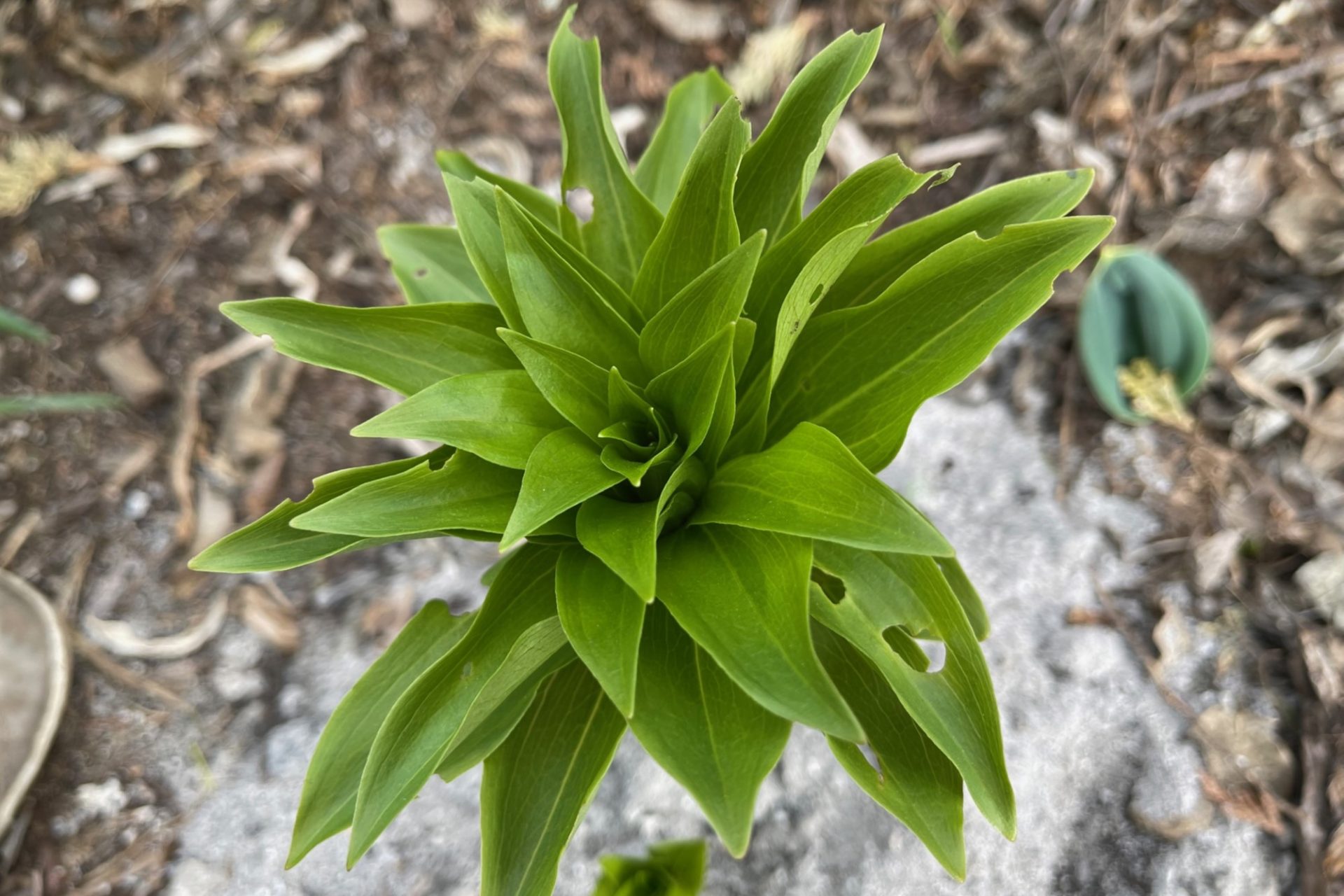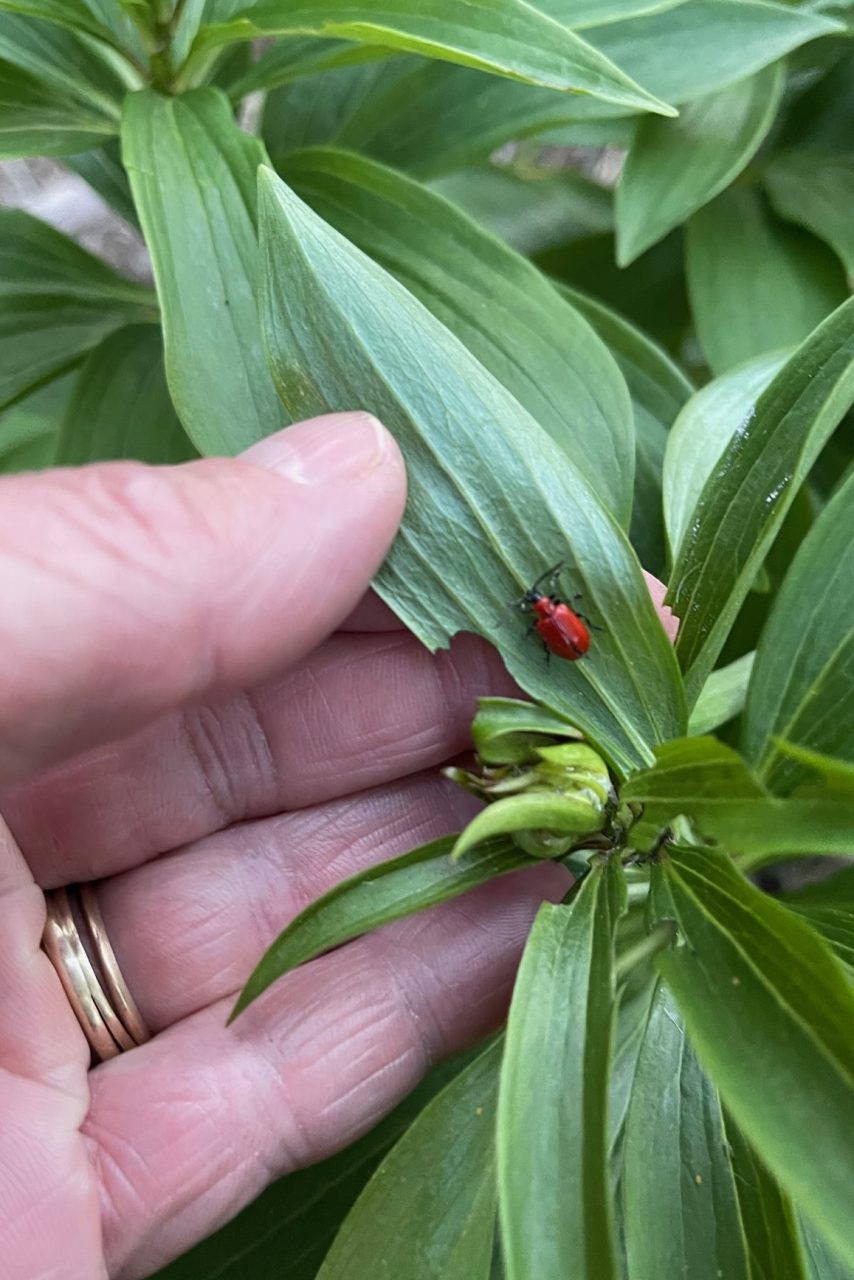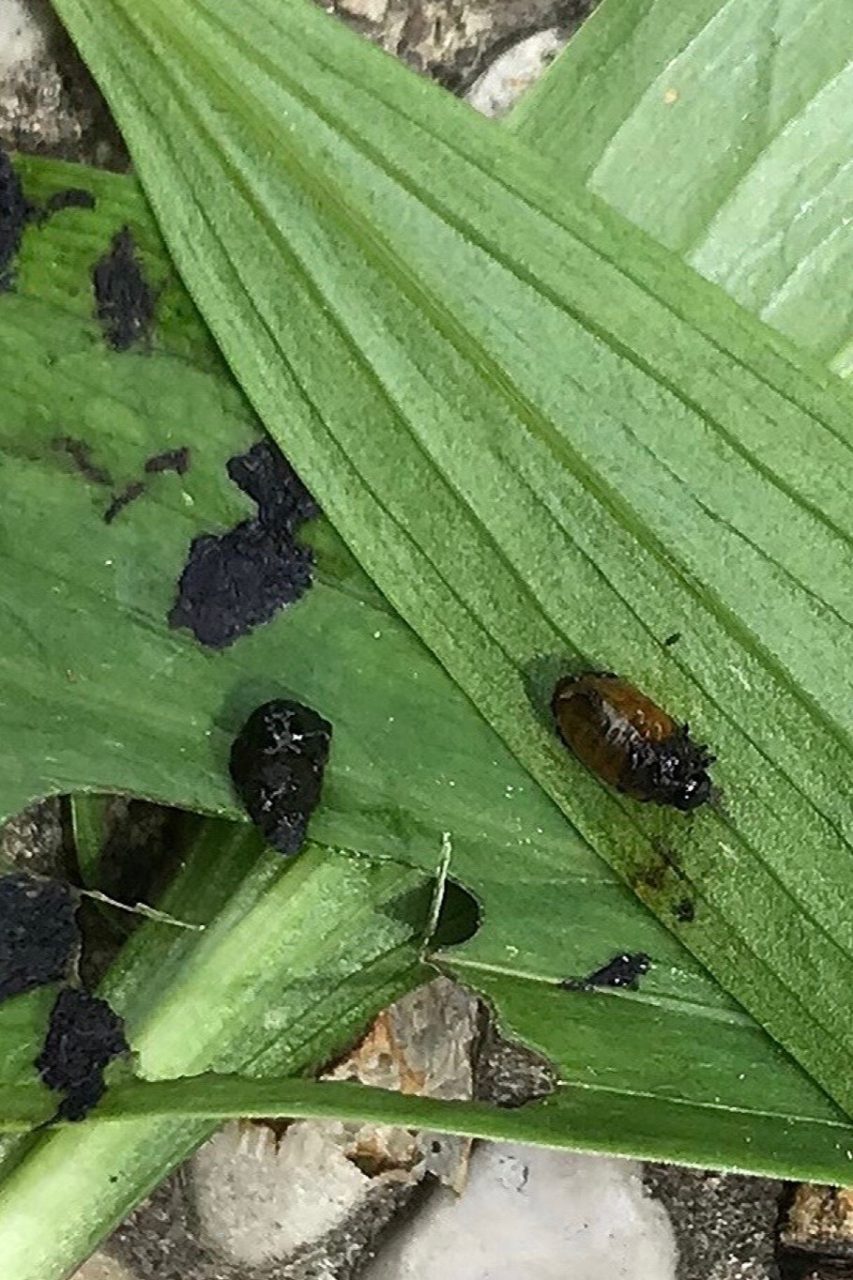Scarlet Lily Beetles are incredibly destructive bugs. Scarlet Lily Beetles can rapidly defoliate patches of lilies in mere days, and they have been spreading from garden to garden across Canada and the United States.
If you have Scarlet Lilies in your garden, this blog is for you!
This blog will explain which kinds of lilies are threatened by Scarlet Lily Beetles, describe the life cycle of Scarlet Lily Beetles, and highlight ways to get rid of Lily Beetles naturally.
What is a Scarlet Lily Beetle?

Scarlet Lily Beetles have a few different names. Besides ‘Scarlet Lily Beetles’, they are called ‘Red Lily Beetles’, ‘Lily Beetles’, ‘Lily Leaf Beetle’, and ‘SLBs’.
Scarlet lily beetles have bright red, rectangular shaped bodies. The rest of their bodies are black, including their heads, 2 large antennae, 6 legs, and their underbellies.
The Latin name for Scarlet Lily Beetle is ‘lilioceris lilii’.
Lily Leaf Beetles have been steadily migrating across Canada from Quebec over the last 20 years, thought to have hitchhiked a ride on lilies from Europe. They have become endemic to prairie gardens in Canada, worse in city centers than in rural areas.
Which Plants Do Scarlet Lily Beetles Target?

Scarlet Lily Beetles target lilies that have slender leaves that grow on stalks, such as Asiatic, LA Hybrids, Martagon, Oriental, and Tiger lilies.
Lily Leaf Beetles also feed on Fritillaria, but those plants aren’t hardy in central Alberta Zone 3 & 4 gardens.
Hemerocallis, also called Daylilies, aren’t from the same plant family, so Scarlet Lily Beetles have no interest in them.
The Life Cycle of a Scarlet Lily Beetle
One of the keys to overcoming garden pests is understanding their lifecycles, which equips gardeners to react quickly to effectively and decisively reduce their populations.
The lifecycle of a Scarlet Lily Beetle is typical of any other beetle, with 4 instars or stages.
Juvenile lily beetles overwinter in the top layers of soil, usually within 5-7.5 cm (2-3′) from the surface, and emerge as mature adults, ravenously hungry and ready to breed in early spring as soon as lilies begin to sprout.
The most common place Lily Beetles hide is hanging upside down on the dorsal, or underside, of leaves. Additionally, they also frequent lily stalks, where leaves and stalks intersect where they are often paired up, mating side by side.

Once they’ve mated, female beetles can lay 250 red, oblong-shaped eggs. They lay their bright red eggs on the undersides of leaves in tidy, linear rows.
The next step in a Scarlet Lily Beetle’s lifecycle is the hatching larvae.

The dark grey larvae hatch on the leaves’ undersides, right where their eggs were laid. They cover their bodies with their excrement for protection from predators as they feed on Lily leaves. The result is a disgusting, squishy, brown blob.
As the beetle matures, it morphs into an orange-red juvenile that looks like a miniature version of an adult Scarlet Lily Beetle.
This process takes most of the summer to complete, and, fortunately, there’s only one generation of Scarlet Lily Beetles each year.
As the weather cools for winter, the juvenile beetles burrow into the top 5 cm (2″) of soil to hibernate for the winter, and the life cycle repeats.
Telltale Signs of Scarlet Lily Beetles

The first spring signs that Scarlet Lily Beetles are in a lily patch are large, irregularly shaped, round holes in the middle and along edges of Lily leaves left by the recently emerged, feeding adults.
Interestingly, more damage is caused by the feeding larvae than by the adults and leaf signs are more apparent than the Lily Beetles themselves.
Scarlet Lily Beetles hang upside down on the bottom side of the leaves. However, as soon as they sense any danger, they drop onto their back into the soil, exposing their black underbelly, which camouflages them against the ground.
Good luck finding them, then!
Strategies to Get Rid of Scarlet Lily Beetles
Combatting Scarlet Lily Beetles centers around prevention and elimination as we focus on the different life stages.
Careful inspection of the lilies during each phase of the growing season is vital to successfully controlling Lily Leaf Beetles.
How to Prevent Scarlet Lily Beetles in the First Place
The simplest way to eliminate Scarlet Lily Beetles from a garden is to eliminate the plants that attract them.
But if you’re anything like me, this solution makes you want to squirm. I had a wide selection of Lily varieties, and loved them all. But, because of the challenge I faced with these beetles, I ended up reducing my lily collection and saving the ones most dear to me.
Now, I implement the following methods to keep the Scarlet Lily Beetles at bay.
How to Get Rid of Adult and Juvenile Scarlet Lily Beetles
The first Lily Beetles encountered in spring are the juveniles.
As mentioned earlier, Scarlet Lily Beetles often live upside down on the undersides of Lily leaves. However, when they sense the slightest danger, they drop off the leaf backwards, landing on their red backs and exposing their black underbellies against the dark earth.
This is a unique and effective protective mechanism typical of beetles because it makes them next to impossible to see.
Few chemicals are effective against Scarlet Lily Beetles; some gardeners find Doktor Doom and Neem Oil fairly effective, but chemical solutions aren’t my favourite fix. Interestingly, the northeastern United States is seeing success with introducing a parasitic wasp.

Even when using chemicals with Scarlet Lily Beetles, the bugs need to be tracked down, and since you’re tracking them down, why not just catch them manually without pesticides?
Instead, take along a dish with soapy water and hunt for them.
When you find them, place the dish underneath the leaf that has the beetle, tap the leaf, and the beetle will fall back into the soapy water.
When you get good at finding these beetles, you can tap them off into your hand and place them in a Ziplock bag.
I create a routine where I go out every day or every other day to check for Lily Leaf Beetles as I look at other aspects of my garden. It’s just part of ‘doing my rounds’.
How to Get Rid of Scarlet Lily Beetle Eggs
Scarlet Lily Beetles lay eggs very soon after they mate, and it takes about two weeks for the eggs to hatch, so you have a little time if you miss them.
Inspect the undersides of the Lily leaves regularly for bright red oblong eggs laid in tidy lines.
They can be crushed or removed from the leaf, but I prefer to take off the whole leaf, put it in a sealed plastic bag, and place it in the garbage.
Another alternative is to burn them, be sure NOT to place these in the compost pile.
How to Get Rid of Scarlet Lily Beetle Larvae

Scarlet Lily Beetle larvae hatch about two weeks after the eggs are laid.
Carefully inspect the undersides of the Lily leaves and gently remove any leaves containing larvae; they will look brown and gooey as they continually cover themselves with their fecal matter.
Place the leaves into a securely sealed plastic bag, which will cause the larvae to suffocate.
Place the bag in the garbage or burn it, and again, do NOT place this in a compost pile, which could be a welcome environment for their growth.
Fall Strategies to Combat Scarlet Lily Beetles
Fall is another time to impact Scarlet Lily Beetle populations.
In late August or in September, cut back lily plant stalks even with the surrounding soil if they haven’t died back already.
Then ruffle the soil in a circle around the stalks to 45 cm (1.5′) away to disturb any nesting beetles and apply a generous amount of wood ashes and diatomaceous earth, which will make the area less hospitable for them.
Wood ashes and diatomaceous earth have a rough texture that messes with their tender bellies.
Disturb the soil every two weeks until it snows, even if it is cold, to expose the beetles to freezing temperatures.
As you do this, mix in more ashes or diatomaceous earth to add another layer.

Be ready to look for these bright red bugs as soon as you see Lily leaves break ground in spring.
Stopping Scarlet Lily Beetles
Having dealt with armies of Scarlet Lily Beetles in my garden, I can tell you that persistence pays off. I did thin out my lilies, but I still implement these strategies each year with my remaining lily clumps.
It has taken perseverance, but Scarlet Lily Beetles aren’t controlling my garden activities, they are just a part of my routine garden spring care, and YOU can win at this too! If you have any more questions about getting rid of Scarlet Lily Beetles or other pests that may be invading your garden, please reach out!
©Sharon Wallish Murphy ©Gardening with Sharon































